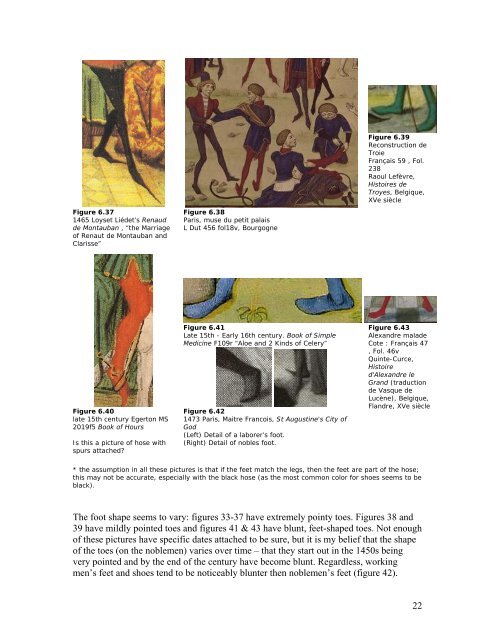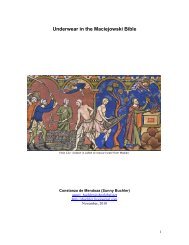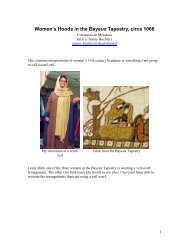Burgundian Noblemen's Underclothes c1445-1475
Burgundian Noblemen's Underclothes c1445-1475
Burgundian Noblemen's Underclothes c1445-1475
You also want an ePaper? Increase the reach of your titles
YUMPU automatically turns print PDFs into web optimized ePapers that Google loves.
Figure 6.37<br />
1465 Loyset Liédet’s Renaud<br />
de Montauban , “the Marriage<br />
of Renaut de Montauban and<br />
Clarisse”<br />
Figure 6.40<br />
late 15th century Egerton MS<br />
2019f5 Book of Hours<br />
Is this a picture of hose with<br />
spurs attached?<br />
Figure 6.38<br />
Paris, muse du petit palais<br />
L Dut 456 fol18v, Bourgogne<br />
Figure 6.41<br />
Late 15th - Early 16th century. Book of Simple<br />
Medicine F109r “Aloe and 2 Kinds of Celery”<br />
Figure 6.42<br />
1473 Paris, Maitre Francois, St Augustine's City of<br />
God<br />
(Left) Detail of a laborer’s foot.<br />
(Right) Detail of nobles foot.<br />
Figure 6.39<br />
Reconstruction de<br />
Troie<br />
Français 59 , Fol.<br />
238<br />
Raoul Lefèvre,<br />
Histoires de<br />
Troyes, Belgique,<br />
XVe siècle<br />
Figure 6.43<br />
Alexandre malade<br />
Cote : Français 47<br />
, Fol. 46v<br />
Quinte-Curce,<br />
Histoire<br />
d'Alexandre le<br />
Grand (traduction<br />
de Vasque de<br />
Lucène), Belgique,<br />
Flandre, XVe siècle<br />
* the assumption in all these pictures is that if the feet match the legs, then the feet are part of the hose;<br />
this may not be accurate, especially with the black hose (as the most common color for shoes seems to be<br />
black).<br />
The foot shape seems to vary: figures 33-37 have extremely pointy toes. Figures 38 and<br />
39 have mildly pointed toes and figures 41 & 43 have blunt, feet-shaped toes. Not enough<br />
of these pictures have specific dates attached to be sure, but it is my belief that the shape<br />
of the toes (on the noblemen) varies over time – that they start out in the 1450s being<br />
very pointed and by the end of the century have become blunt. Regardless, working<br />
men’s feet and shoes tend to be noticeably blunter then noblemen’s feet (figure 42).<br />
22






